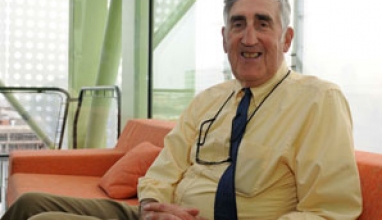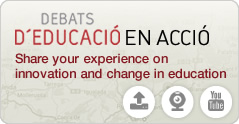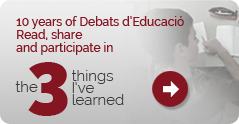You are here
Perennial Dilemmas Policymakers and Practitioners Face in the Adoption and Classroom Use of ICTs: The US Experience
About the speaker
Larry Cuban
Emeritus Professor, School of Education, Stanford University
Main idea
Since the 1980s, US governments have invested thousands of dollars in the introduction of ICTs in classrooms. We have gone from one computer per 124 students in 1983 to 4 computers per student in 2006.
Despite this, Larry Cuban highlights how studies arrive at two surprising conclusions:
1. That the adoption of ICTs has not seen a substantial improvement in school results, nor a change in the way teachers teach.
2. That teachers use technological tools at home, to find out more, to search for information, to download videos that they will use later, to communicate via email but they use these tools much less frequently in the classroom.
The factors affecting the US school system
The educational system is marked by what Cuban calls schools DNA, which is determined by:
• The fact that citizens pay their taxes to make public schools possible, which means that they want results.
• The desire that there has always been for education to drive change in other areas, whether economic, political or social. There have been different social movements that have promoted educational reforms. This was the case of the progressive movements at the end of the 19th century which fought against political corruption and for solutions to the problems of immigration; or the human rights movements and those fighting racial segregation in the 1950s, which also promoted changes in education. From the 1970s onwards, the idea has been that education has to help countries be stronger beyond their borders, to be competitive, and this determines the type of education and prioritises curriculum and results.
• The fact that political elites legislate from above, without taking into account the reality of educational practice. Changes in legislation are hard to put into practice in schools because teachers are free to do what they want in class.
• The distribution of schools by age.
Why the potential of ICTs is not being fulfilled in the US, according to Cuban.
• Teaching and learning are unpredictable phenomena, affected by many external factors (social conditions, the interests of each student) and internal factors (type of activity being developed, for example). However, the studies carried out to ascertain the effect of the adoption of ICTs in classrooms use methods that fail to reflect this complexity. More accurate research is much more expensive.
• Schools, for parents, have a function for learning, not just in content, but also in values. Students are expected to socialise, to learn moral values, to have a critical spirit. These issues cannot be addressed through ICTs, but instead through the key figure of the teacher.
• There is fear of the social future. Parents and the political elite are applying pressure to maintain the rigid, wide-ranging curriculum because they feel that this way students will succeed and ensure a competitive country. Teachers have little room for manoeuvre if they want to achieve the results demanded. They have to restrict their lessons to 45 minutes and deal with many different students (different class groups).
• Only 40% of teachers commonly use ICTs in the classroom. Many of them use them to develop traditional teaching. Very few of them use these tools creatively and to add value to the learning.
• Researchers see teachers as living with the perennial dilemma of balancing their academic role (as a broadcaster of content) and their emotional role (knowing each student, knowing what their interests are, etc.). Some defend their academic role they have to objectively judge students knowledge, and, thus, cannot create emotional bonds. Others believe that students learn more if there is an emotional bond between them. Cuban believes there is the need to find a balance and ICTs could aid this.
• In the US, traditional classes, where teachers explain and students listen in silence are those that are highly rated. The use of ICTs provides another way of organising and working in the classroom in groups, with greater participation, with more dialogue between students and this is often not well regarded by school heads.
• ICTs mean that students have quick and easy access to information. Sometimes, they even have more information than the teachers, as students are often better skilled in the use of technologies than their teachers. This fact can undermine the authority of the classic teacher.
• ICTs help schools substitute the central role of the teacher for that of the student. In this model, teachers can guide and aid access to information, but they are not the focal point for the education. However, not everyone wants or is capable of this type of education.
Conclusions
Introducing change in the US educational system to use ICTs for another kind of teaching that could truly maximise their potential would be slow and difficult. All technological change has been slow. But any educational reform can only be achieved if there is social support, as has been the case at other times in US history. Legislation is not enough, because schools DNA makes change difficult. And, currently, society supports a kind of conservative education based on competitive results.
Discover
other ideas
-

The Influence of Origin and Destination Countries...
Jaap Dronkers
2010 -

Decline of Schools and Conflicts of Principles
François Dubet
2010 -

Educational Excellence for Everyone: A Possible Re...
Roser Salavert
2010











 The texts published on this website are, unless otherwise indicated, covered by the Creative Commons Spain Attribution - Non Commercial - No Derivs 3.0 licence. You may copy, distribute and transmit the work, provided you attribute it (authorship, journal name, publisher) in the manner specified by the author(s) or licensor(s). You may not use the material for commercial purposes. You may not transmit any derivative work from this material. The full text of the licence can be consulted here:
The texts published on this website are, unless otherwise indicated, covered by the Creative Commons Spain Attribution - Non Commercial - No Derivs 3.0 licence. You may copy, distribute and transmit the work, provided you attribute it (authorship, journal name, publisher) in the manner specified by the author(s) or licensor(s). You may not use the material for commercial purposes. You may not transmit any derivative work from this material. The full text of the licence can be consulted here: